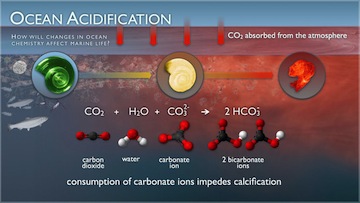330914-blurry vision.jpg

The oceans are getting more acidic as they absorb carbon dioxide from the atmosphere. Credit: National Oceanic and Atmospheric Administration
The picture on that high-def TV in your den refreshes every sixtieth of a second or faster – a rate that allows your brain to see the sequence of pictures as smooth motion. But if the rate gets too fast, the brain can’t put it together – all you see is a blur. That’s a problem that may afflict some species of fish as the oceans get more acidic. The acid may affect nerve cells that carry impulses from the eye to the brain. In essence, that could slow down a fish’s vision, making it tougher to find food or avoid predators.
The oceans are getting more acidic as they absorb carbon dioxide from the atmosphere. Many studies have shown that the extra acid can damage corals and the shells of shellfish. Others have suggested other negative effects, including the problem with vision.
Scientists tested how damselfish react to different levels of acid in the water – from the levels found today, to those projected for the end of the century if the amount of carbon dioxide in the atmosphere goes up as expected.
The tests showed that as the level of acidity increased, the fish basically “saw” fewer pictures per second. Beyond that rate, everything was just a blur. And in the oceans, where both prey and predators can move in a hurry, that could mean the difference between life and death.
The experiments looked at only one species of fish, but thousands of others have similar nerve cells. That suggests that in the decades to come, many fish may not get as clear a picture of their ocean surroundings.

